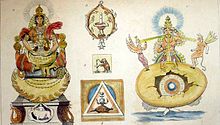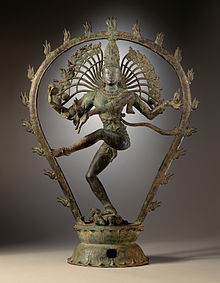Kottiyoor Vysakha Mahotsavam
| Kottiyoor Vysakha Mahotsavam | |
|---|---|
Saka Calendar :Jyaistha; (Gregorian Calendar:June–July) | |
| Related to | Daksha Yaga |
| Part of a series on |
| Hinduism |
|---|
 |
Kottiyoor Ulsavam or Kottiyoor Vysakha Mahotsavam (
In

The Ikkare Kottiyoor temple and Akkare Kottiyoor temple are dedicated to Mahadeva. The Vavali River flows between the shrines. The Ikkare Kottiyoor temple is believed to have been created by
Period of pilgrimage
The festival occurs from the Swati Nakshatra of the
Even though the pilgrimage is called Kottiyoor Ulsavam or Kottiyoor Festival, the programs related to the pilgrimage are only religious rituals there are no entertainment programs like festivals in other temples. Only Vedic hymns are recited and priestly rites and rituals performed.
Legend
Daksha Yagna was an important turning point in the creation and development of sects in Hinduism like
Daksha organised a huge yaga and intentionally avoided Shiva and Sati. Even though discouraged by Shiva, who told her not to go to a function where she and her husband was uninvited; the personal bondage with her parents made Sati ignore social etiquette and her husband's wishes. Sati without Shiva went to the ceremony. She was snubbed by Daksha and insulted by him in front of the guests. Sati unable to bear further insult ran into the Sacrificial fire and immolated herself. Shiva upon knowing the terrible incident in his wrath invoked
The story continues by the act of Vishnu in pacifying Shiva, who was in deep grief in seeing the half burned corpse of his beloved wife. Vishnu embraced Shiva to pacify him. Shiva unable to part with Sati took her corpse and wandered. The body parts of the corpse of
Vaishakha Festival rituals
Kottiyoor Ulsavam is conducted in the Tiruvanchira pond in rainy season where only hay thatched huts are allowed. The sacred pond is a
The ceremonies for the Kottiyoou Festival, performed in sequential order, are

Purakkuvam
Rohini aradhana is an important ceremony. Kurumathoor Nayikan Brahman, the title of the head of a Vaishnavite family in the area, who has the birthright for the ceremony, performs the rite. He is considered a representation of Vishnu. The Namboothiri performs the rites and embraces the Swayambhu Shivalinga, i.e. Alingana Pushpanjali. This commemorates the incident which took place during the Daksha yaga. Shiva was in heartbreaking sorrow, when he saw the burned dead body of his beloved wife Sati. Rohini aradhana, is a reminder of how Vishnu embraced Shiva to pacify and comfort his dear mate.
Entry of Parashurama
Ages after the dreadful incident and havoc, carrying Sati Devi's tears and curse, the land started being governed by
Exclusiveness in rites
- Usha pooja is only for twenty-four days to match with the standard yaga period. However the rest of the pooja is conducted for all twenty-seven days.
- The quantity of Nivedyam is fixed as in ancient time. It not increased proportional to an increase in the number of pilgrims.
- No pooja is performed at Ammarakkal (Sati Devi's suicide site) only Pushpanjali and Nivedyam is offered.
- Punyaham is never performed, as the location is blessed with the congruence of the Shaiva, Shakta, Vaishnava divinities. Kottiyoor is so pure that all impurities are washed away. The location is the origin of a spring which form part of the Vavali River. The festival takes place during the rainy season.
- Ganapathi Homam is performed every day in morning.
- The whole premises is a temporary shelter and it is a replica of the ancient Vedic worship and culture, thousands of years ago. Unlike most pilgrimage sites there is no permanent temple structure. The pradakshinam (circumambualtion) is through a pond.
Access
The national highway passes through
Image gallery
-
Festival Time
-
Ikkare Kottiyur
-
Entry to Akkare
-
Bamboo Flower Maker
-
The Temple Bridge
-
Bubble Maker
-
Going to Akkare Kottiyur
-
festival view
-
Bringing Tender Coconuts
-
The Bunyan Tree
See also
- Virabhadra-Daksha
- Shaivism-Shaktism
- Shakti Peethas
- Kottiyoor, Thalassery, Kerala
- Kottiyoor Vadakkeshwaram Temple-Tirunelli Temple
References

- ^ "Vaisakha Maholsavam dates for year 2013". 2013. Retrieved 20 July 2013.
19-June-2013, Wednesday - Thrukkalassattu
- ^ "Daksha Yagnam". The Hindu. 19 August 2009. Archived from the original on 22 August 2009. Retrieved 20 July 2013.
- ^ "Thousands throng Kottiyur temple". The Hindu. 7 June 2005. Archived from the original on 18 June 2005. Retrieved 19 August 2013.
- ^ "Huge crowd at Kottiyur temple". The Hindu. 17 June 2006. Retrieved 7 July 2018.
- ^ "Few Facts about the temple". Kottiyoor Devaswom. Retrieved 11 August 2013.
- ^ "Kottiyoor Shiva Temple". touristplaces.org. Retrieved 13 August 2013.
- ^ the Horse-sacrifice of the Prajapati Daksha The Mahabharata translated by Kisari Mohan Ganguli (1883–1896), Book 12: Santi Parva: Mokshadharma Parva: Section CCLXXXIV. p. 317. "I am known by the name of Virabhadra’’ and I have sprung from the wrath of Rudra. This lady (who is my companion), and who is called Bhadrakali, hath sprung from the wrath of the goddess."
- ^ "The Hindu : Kerala / Kannur News : Huge crowd at Kottiyur temple". www.hindu.com. Archived from the original on 1 October 2007. Retrieved 17 January 2022.
- ^ "Kottiyoor Devaswam Temple Administration Portal". Kottiyoordevaswom.com. Retrieved 20 July 2013.
- ^ "Parashurama's entry". Kottiyoordevaswom.com. Archived from the original on 11 August 2013. Retrieved 11 August 2013.
Bibliography of notable offline sources
- Ancient Indian Tradition and Mythology: Mahapuranas-The Vayu Purana. UNESCO Heritage Publishing, (United Nations Organization). 1987. ISBN 9231030175.
- )
- Ramesh Menon (2011). Siva: The Siva Purana Retold (1, Fourth Re-print ed.). Rupa and Co. ISBN 978-8129114952.
- )
- (Translator), Swami Vijnanananda (2007). The Srimad Devi Bhagavatam. Munshiram Maniharlal. )
- Dallapiccola, Anna L (2002). Dictionary of Hindu Lore and Legend. Thames & Hudson. ISBN 0500510881.
Further reading
- )
- )
External links












